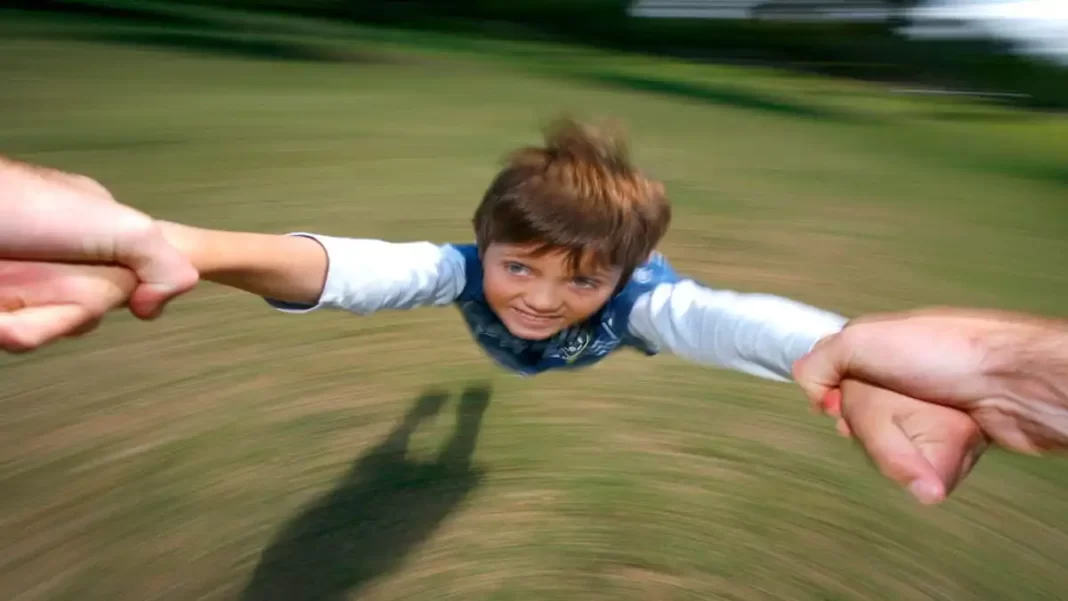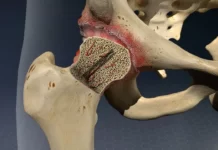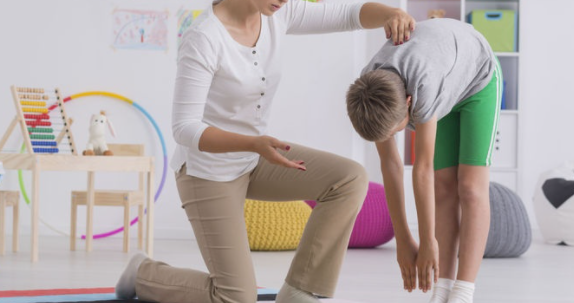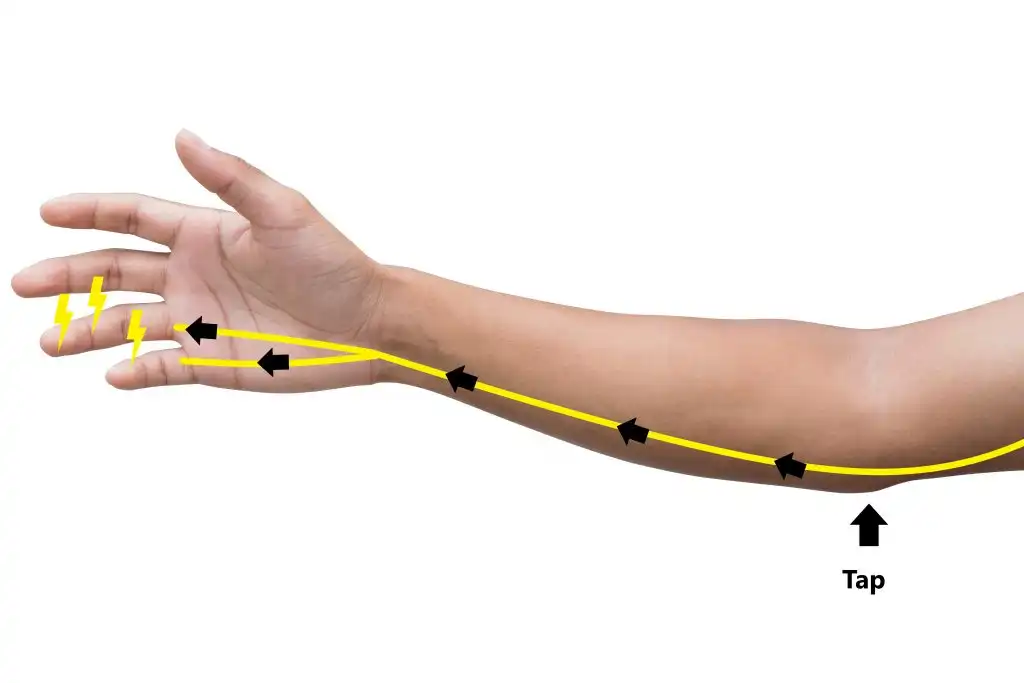Introduction
Elbow subluxation, also known as “partial dislocation,” is a delicate condition that can occur in children, typically between the ages of 1 and 4 years old. This occurrence is characterized by the partial displacement of the elbow joint, often resulting from sudden traction or force applied to the child’s arm. It is more frequently observed in girls and can occur during play activities or games, where a sudden pull on the arm is exerted, such as that generated by pulling the child by the arm.
Symptoms of elbow subluxation in children may include mild to moderate pain, resistance to moving the affected arm, and sometimes a slight deformity of the joint. The child often avoids using the affected arm due to the pain. While subluxation can be a cause for concern for parents, it is crucial to emphasize that it is usually a reversible situation, and the prognosis is favorable with appropriate treatment.
Treatment typically involves the manual reduction of the joint, performed by a healthcare professional. Following this procedure, careful evaluation and follow-up measures are essential to ensure optimal healing. In some cases, a brief period of immobilization using a splint may be recommended, followed by rehabilitation exercises aimed at strengthening the muscles and restoring mobility to the elbow joint.
Parents play a crucial role in the treatment process by adhering to the healthcare professional’s advice and avoiding activities that could potentially traumatize the child’s elbow. By providing attentive support and actively participating in rehabilitation, parents contribute to ensuring their child’s full recovery and minimizing the risk of elbow subluxation recurrence.
Causes of elbow subluxation in children
Elbow subluxation is a common injury among young children. This condition occurs when the forearm bone (radius) slips out of its joint with the upper arm bone (humerus) at the elbow. This can occur relatively easily in children due to the nature of their anatomy and developing musculoskeletal system.
Here are some reasons why elbow subluxation is more common in young children:
- Loose Ligaments: The ligaments that hold the elbow joint in place in young children are often looser than in adults. This makes the joint more prone to dislocations or subluxations.
- Muscle Development: Young children do not yet have the muscular strength and fine motor control necessary to fully stabilize their joints, including those at the elbow.
- Physical Activities: Children are often very active and engaged in physical play. They may be prone to jerking or swinging, increasing the risk of elbow subluxation.
- Sudden Pull: Elbow subluxation in children is often caused by a sudden pull of the arm, such as when the child is pulled by the arm or holds on to something.
List of Causes
- Pulling or Jerking of the Arm: The most frequent cause is a sudden pulling or jerking of the child’s arm, commonly seen during play or activities. This can happen when an adult or another child pulls the child’s arm, especially when it is fully extended.
- Lifting or Swinging by the Arms: Lifting or swinging a child by their arms, particularly when they are in an extended position, can lead to elbow subluxation. This action puts stress on the ligaments and structures around the elbow joint.
- Falls: Falls, especially if the child lands on an outstretched arm, can result in elbow subluxation. The impact and force transmitted through the arm during a fall can disrupt the alignment of the joint.
- Play Activities: Common play activities, such as swinging a child by the arms, playing tug-of-war, or even spinning a child rapidly, can contribute to the development of elbow subluxation. These activities involve sudden forces on the arms.
- Sports and Recreational Activities: Participation in certain sports or recreational activities where there is a risk of sudden arm movement or impact can increase the likelihood of elbow subluxation. Vigorous play without proper support or precautions may lead to this condition.
- Natural Ligament Laxity: Young children have developing ligaments and joints that are inherently more flexible and have greater laxity. This natural laxity makes their elbows more susceptible to subluxation with less force than would affect older individuals.
- Age and Developmental Stage: The age and developmental stage of a child play a significant role. Elbow subluxation is more common in younger children, typically between the ages of 1 and 4, as their joints and ligaments are still in the early stages of development.
- Previous Episodes: Children who have experienced nursemaid’s elbow before might be more prone to recurrent subluxations. Once a child has had this condition, the ligaments around the elbow may be slightly weakened, making future occurrences more likely.
- Quick Movements and Twisting: Rapid and unexpected movements, as well as twisting of the arm, can contribute to elbow subluxation. Children engaging in activities that involve sudden changes in direction or quick arm movements may be at an increased risk.
- Handling Resistance: When an adult or caregiver encounters resistance while holding a child’s hand or arm and continues to exert force, the child’s elbow can be subjected to excessive stress, leading to subluxation.
- Improper Lifting Techniques: Lifting a child improperly, especially if the child’s arm is pulled or twisted during the process, can result in elbow subluxation. It is essential for caregivers to use proper lifting techniques to avoid unnecessary stress on the child’s joints.
- Genetic Factors: While less common, there may be genetic factors contributing to ligament laxity in some children. If a family has a history of joint-related issues, it could potentially increase the predisposition to elbow subluxation.
- Playful Roughhousing: Engaging in playful roughhousing or wrestling with peers can increase the risk of elbow subluxation. Sudden and uncontrolled movements during play can put stress on the child’s joints.
- Underlying Ligamentous Laxity: Some children may naturally have more lax ligaments, a condition known as ligamentous laxity. This inherent flexibility can make their joints more susceptible to subluxation even with minimal force.
- Sudden Stops or Pulls in Play: Abrupt stops or pulls during activities like tag or other games where children may grab each other can lead to sudden forces on the arms, potentially causing elbow subluxation.
- Lifting During Tantrums: Lifting a child who is resisting or having a tantrum, especially if the child pulls away forcefully, can result in elbow subluxation. It is important to be cautious during such situations.
- Sports Activities: Participating in certain sports activities, especially those involving pulling, twisting, or sudden changes in direction, can contribute to elbow subluxation. Proper coaching and supervision are essential to reduce the risk.
- Improper Carrying Techniques: Carrying a child in a manner that puts excessive stress on the arms, such as swinging them by the hands or wrists, can lead to elbow subluxation. Caregivers should be mindful of proper carrying techniques.
- Fast Spinning Movements: Activities that involve rapid spinning or twirling, whether done by an adult or during play, can exert significant forces on a child’s arms and contribute to elbow subluxation.
- Weak Muscles Around the Elbow: Weakness in the muscles supporting the elbow joint can increase the vulnerability to subluxation. Regular exercises to strengthen these muscles may help reduce the risk.
- Inadequate Warm-up Before Activities: Engaging in physical activities without proper warm-up may increase the risk of elbow subluxation. Warm-up exercises help prepare the muscles and joints for movement.
- Uncontrolled Swinging: Uncontrolled swinging, either on playground equipment or during play, where the child’s arms are subjected to sudden and forceful movements, can lead to elbow subluxation.
- Hyperextension of the Elbow: Children who frequently hyperextend their elbows, either as a habit or during certain activities, may be at an increased risk of elbow subluxation. Hyperextension puts additional stress on the joint ligaments.
- Uneven Arm Strength: Significant differences in strength between the two arms can contribute to subluxation, especially if one arm is consistently subjected to more force or strain during activities.
- Carrying Heavy Objects: Carrying heavy objects or backpacks, especially if the weight is unevenly distributed, can alter the balance and increase the likelihood of sudden movements that may result in elbow subluxation.
- Joint Hypermobility: Children with joint hypermobility, where their joints can move beyond the normal range, may be more prone to elbow subluxation. This increased flexibility can make the joint more susceptible to displacement.
- Sudden Bracing or Breaking a Fall: Children instinctively use their arms to brace or break a fall. In certain situations, this can lead to abrupt forces on the elbow joint, potentially causing subluxation.
- Playing on Uneven Surfaces: Uneven surfaces, such as bumpy playgrounds or rocky terrain, can increase the risk of tripping or falling, potentially resulting in elbow subluxation if the child tries to catch themselves.
- Joint Instability due to Injury: A previous injury to the elbow or surrounding structures can create joint instability, making it more susceptible to subluxation during routine activities.
- Joint and Ligament Development: The ongoing development of joints and ligaments in growing children can make them more prone to subluxation, especially as these structures may not be fully stabilized until later stages of childhood.
- Environmental Factors: Environmental factors, such as crowded or confined spaces, may increase the chances of accidental collisions or sudden arm movements that can contribute to elbow subluxation.
- Genetic Predisposition: Some children may have a genetic predisposition to joint-related conditions, including ligamentous laxity, which can elevate the risk of elbow subluxation.
It is important to note that elbow subluxation is usually repairable and does not usually cause permanent damage. However, to avoid these incidents, here are some tips:
- Careful Handling: Avoid pulling sharply on a child’s arm or lifting them by their hands.
- Activity Monitoring: Keep an eye on the child’s physical activities to minimize the risk of pulling or sudden movements.
- Caregiver Education: Parents, teachers, and caregivers should be informed of the potential risks and ways to prevent elbow subluxation.
Symptoms of elbow subluxation in children
List of symptoms
- Pain: The child may experience pain around the elbow area.
- Refusal to use the arm: Due to the discomfort, the child might be hesitant to move or use the affected arm.
- Holding the arm in an abnormal position: Children with elbow subluxation may keep the affected arm in a slightly flexed and pronated position.
- Crying or distress: The pain and discomfort can lead to visible signs of distress, with the child crying or expressing discomfort.
- Limited range of motion: There may be a noticeable reduction in the range of motion of the affected arm.
- Tenderness around the elbow: Touching or pressing on the elbow area may cause tenderness.
- Immediate onset of pain after a pull: The child might immediately complain of pain following an incident where their arm was pulled or yanked.
- Reluctance to use the affected arm for daily activities: Due to the discomfort, children may avoid using the affected arm in activities like reaching for objects or playing.
- Swelling or bruising: While less common, there might be some swelling or bruising around the elbow joint.
- Guarding the arm: The child may instinctively guard or protect the affected arm, holding it close to their body.
- Pronounced pain during specific movements: The child may experience more significant pain when attempting certain movements, such as trying to straighten or rotate the forearm.
- Possible clicking or popping sensation: In some cases, there might be a clicking or popping sensation felt around the elbow joint during the injury or when attempting to move the arm.
- Difficulty in gripping or holding objects: Children with elbow subluxation may find it challenging to grip or hold onto objects due to pain and limited mobility.
- Changes in behavior: Younger children, in particular, may exhibit changes in behavior, becoming more irritable or fussy, especially when the affected arm is touched or moved.
- Visible discomfort during examination: When a healthcare professional examines the affected arm, the child may express discomfort or pain, aiding in the diagnosis.
Management of elbow subluxation in children
Managing elbow subluxation in children involves a comprehensive therapeutic approach aimed at alleviating pain, restoring normal joint function, and minimizing the risk of recurrence. Healthcare professionals, including osteopaths, play a pivotal role in this process. One primary aspect of the therapeutic strategy is closed reduction, a gentle maneuver performed by professionals to guide displaced bones back into their proper position. This procedure is typically quick and causes minimal discomfort to the child. Pain management is another crucial element, often involving the recommendation of over-the-counter pain relievers like acetaminophen or ibuprofen. The choice of medication and dosage is determined by healthcare providers based on the child’s age and medical history.
Immobilization through a sling or splint is employed in certain cases to temporarily restrict movement, reducing strain on the healing joint and facilitating a more rapid recovery. Concurrently, rehabilitation exercises form an integral part of the therapeutic approach. Professionals prescribe gentle exercises and stretches to restore strength and range of motion to the affected elbow. These exercises are initiated under guidance to prevent further injury and promote optimal recovery.
Equally important is the education of caregivers, primarily parents, and guardians. They are provided with essential information on how to handle and support the child during the recovery period. Understanding preventive measures, such as avoiding sudden pulls on the arm, is crucial in minimizing the risk of recurrence. Caregivers become integral partners in the child’s healing process, ensuring a supportive environment conducive to recovery.
Regular follow-up care is a cornerstone of the therapeutic approach. Healthcare providers schedule appointments to monitor the child’s progress, make necessary adjustments to the treatment plan, and address any emerging concerns. This ongoing evaluation ensures that the chosen therapeutic measures are effective and adapted to the child’s evolving needs.
- Manual reduction: A healthcare professional, such as a trained osteopath, will usually perform a manual reduction maneuver to move the elbow joint back into place. This may involve a specific technique, often described as the pediatric elbow subluxation reduction maneuver.
- Post-reduction assessment: After manual reduction, the healthcare professional will assess the child to ensure the joint is correctly repositioned. They will also check for signs of possible complications, such as injury to nerves or blood vessels.
- Temporary Immobilization: In some cases, it may be recommended to temporarily immobilize the elbow using a splint or bandage to allow for proper healing. However, this often depends on the specific case and the recommendations of the healthcare professional.
- Medical monitoring: Medical monitoring is crucial to ensure that the child recovers properly. Follow-up exams may be scheduled to assess joint mobility, monitor for signs of complications, and adjust the treatment plan as needed.
- Rehabilitation exercises: Once the joint is stabilized, rehabilitation exercises may be recommended to strengthen the muscles around the elbow joint and restore full mobility. These exercises are often prescribed by a healthcare professional or physiotherapist.
- Parent and Caregiver Education: Parents and caregivers of the child should be informed about elbow subluxation, its potential causes, and preventive measures to take to avoid recurrence.
- Prevention of future subluxations: Advice can be provided to avoid situations that could lead to recurrent subluxation, such as rough play or inappropriate handling of the child’s arms.
Elbow subluxation reduction maneuver in children
The pediatric elbow subluxation reduction maneuver, or toddler elbow reduction maneuver, generally refers to a technique used to put a child’s elbow back into place, also called radial head subluxation or dislocated elbow. This condition usually occurs in young children, often between 1 and 4 years old.
Elbow subluxation in children occurs when there is a partial dislocation of the radial head away from the annular ligament, usually due to sudden traction on the child’s arm. This is a common pediatric injury and can result from activities such as pulling a child by the arm or lifting them by the hands.
The reduction maneuver is a simple and effective technique performed by healthcare professionals, such as doctors or nurses. It involves gently manipulating the affected arm to guide the radial head to its normal position within the annular ligament.
Here is a basic description of the elbow subluxation reduction maneuver in children:
- Comfort the child: Make sure the child is calm and in a comfortable position, preferably sitting on a parent’s lap.
- Stabilize the arm: Hold the affected arm in a stable position, usually with one hand grasping the forearm and the other holding the hand.
- Pronation and Supination: Gently rotate the child’s forearm, alternating between pronation (palm down) and supination (palm up). This movement helps loosen the grip of the annular ligament on the radial head.
- Flexion and Extension: While maintaining rotation, gently flex and extend the child’s elbow. This movement helps in reduction of the radial head.
- Look for a click or pop: While performing these movements, you may feel a subtle click or pop, indicating that the radial head has returned to its normal position.

It is crucial to note that although the elbow subluxation reduction maneuver in children is a common and generally safe procedure, it must be performed by a healthcare professional to ensure proper technique and avoid any potential complications. After reduction, the child’s arm can be assessed for comfort and functionality, and instructions can be provided to parents or caregivers to prevent future occurrences.
Prevention of elbow subluxation in children
- Careful handling: When lifting a child by the hands, avoid lifting the child abruptly or swinging the child by the arms. Handle the child with care, supporting the trunk rather than the hands.
- Avoid rough play: Rough play that involves pulling the child by the arms, such as playing “musical chairs,” can increase the risk of subluxation. Prefer games that do not involve strong forces exerted on the arms.
- Teaching caregivers: Inform caregivers, including caregivers, teachers, and family members, about precautions to take when handling the child.
- Fall prevention: Avoid situations where the child could fall and be grabbed by the arm. Encourage caution during physical activities.
- Encourage proper use of arms: Encourage the child to use their arms properly during physical activities and games. Teach appropriate movements and emphasize the importance of not pulling on the arms.
- Muscle strengthening: Muscle strengthening exercises, under the supervision of a healthcare professional, may sometimes be recommended to strengthen the muscles around the elbow joint.
Tips for parents
If your child has suffered an elbow subluxation, it is essential to take precautions to ensure recovery and prevent future injuries. Here are some practical tips for parents in this situation:
- Consult a Healthcare Professional: The first step is to immediately consult a healthcare professional, usually a doctor or orthopedist. They will be able to assess the situation, perform joint reduction if necessary, and ensure that no further injury has been caused.
- Avoid Sudden Movements: After subluxation, it is important to avoid any sudden movements of the child’s arm. Avoid lifting him by his hands and make sure he does not participate in physical activities that could put undue stress on the elbow joint.
- Use a Bandage or Splint: In some cases, a healthcare professional may recommend using a bandage or splint to stabilize the elbow joint while it heals. Follow the doctor’s advice on how to apply and remove these devices.
- Keep the Child Comfortable: Make sure the child is comfortable by avoiding placing heavy objects on the affected arm and allowing the child to rest. Use cushions to support the arm when sitting or lying down.
- Watch for Symptoms: Be alert for signs of pain, swelling, or other unusual symptoms. If you observe anything concerning, consult the healthcare professional again.
- Follow Medical Instructions: Strictly follow all medical instructions given by the healthcare professional. This may include physical therapy sessions, prescribed medications, or specific recommendations for activities to avoid.
- Encourage Prevention: Educate the child about preventing elbow subluxations, particularly by teaching them to avoid sudden movements and explaining the importance of not pulling or hooking their arm.
- Schedule a Follow-up Consultation: Be sure to schedule a follow-up consultation with the healthcare professional to assess the child’s recovery and discuss any ongoing problems.
Conclusion
In conclusion, elbow subluxation in children is a complex and important topic that requires a thorough understanding of the associated causes, symptoms, treatments, and preventions. Awareness of these aspects is crucial for parents, caregivers and healthcare professionals to ensure early diagnosis, adequate treatment and optimal recovery.
Prevention efforts, including educating parents about risky behaviors, can help reduce the incidence of elbow subluxation in children. Medical treatment and rehabilitation options, when implemented appropriately, can promote full recovery and minimize potential complications.
Ultimately, collaboration between parents, healthcare professionals, and therapists is essential to ensure the well-being of children affected by elbow subluxation. Continued research and case studies will improve our understanding of this condition, paving the way for more effective prevention and treatment practices in the future.


























